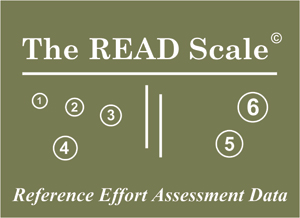
Welcome to The READ Scale Research Web Site
 |
|
Welcome to The READ Scale Research Web Site
|
What is the READ Scale?The READ Scale (Reference Effort Assessment Data) is a six-point scale tool for recording vital supplemental qualitative statistics gathered when reference librarians assist users with their inquiries or research-related activities by placing an emphasis on recording the effort, skills, knowledge, teaching moment, techniques and tools utilized by the librarian during a reference transaction. The READ ScaleWhy develop the READ Scale?A 2002 reference services and assessment survey conducted by the Association of Research Libraries (ARL) hoped to reveal current best practices, but instead "revealed a situation in flux" and "a general lack of confidence in current data collection techniques": With many librarians feeling as busy as ever, some have concluded that the reference service data being collected does not accurately reflect their own level of activity. It was with similar sentiments that the READ Scale was developed. Can anyone use the READ Scale?We welcome and encourage all interested libraries of any type to test and use the READ Scale and contribute to its development as a supplemental tool for gathering and qualifying reference statistics. Currently, more than 400 libraries (known) of all types use the Scale worldwide. The READ Scale is available for any institution to use free of charge. It is also included as an option in the Springshare suite of services. Contact Bella Karr Gerlich at readscale1@gmail.com and an implementation document will be forwarded electronically that will help with the transition to using the tool. Why measure reference statistics using the READ Scale?The 2002 survey conducted by the Association of Research Libraries (ARL) gives supporting evidence that many academic institutions are not completely satisfied with the usefulness of the reference statistics gathered. Using the READ Scale as a supplemental tool, libraries can give recognize the effort, knowledge, skill etc that is required during a reference transaction and also recognize the value-added service that is provided. In addition to recording reference staff personal efforts, there are practical applications for using the READ Scale: Staffing
Training / Continuing Education
Renewed Personal & Professional Interest
Outreach
Research / Statistics
What librarians and libraries say about using the READ Scale:“An assessment tool that does a better job of reflecting how reference librarians spend their time. It gives more value than tick marks on a page. It's a tool we can use with administrators to show what we really do.” “It gives ME a tangible scale on which to rate my efforts, ultimately spurring me to strive for better service.” “Using the READ Scale added to my sense of accomplishment!” “I felt it was very useful because it challenged me to come up higher in those areas where I need improvement in certain concentrations like ____ which is not my specialty. I need to learn so much more.” “We've always known empirically that a large percentage of our reference transactions were quick and easy. This study provided concrete evidence of this, with possible staffing implications.” “It shows a much clearer picture of what we are actually doing with reference. It is possible to see where the true "busiest times" are in the day.” “We have found the Read Scale information to be easy to use and implement and will be continuing this for our fall semester.” “We only sample reference transactions 4 times a year but we will be using READ in the sampling for now on.” Some Institutions Piloting the READ Scale:Indiana University The National READ Scale Study – Bella Karr Gerlich, Ph.D. and G. Lynn BerardResults from a 2003-04 pilot study at Carnegie Mellon University were disseminated at an ALA poster session in Toronto, Canada. Institutional grants received from Georgia College & State University and Carnegie Mellon funded the launch of a national study in 2007, with Bella Karr Gerlich (PI) and G. Lynn Berard as co-researchers at 14 diverse academic libraries. Over 22,000 transactions were analyzed; the return rate of an online survey was 52%, with over 80% indicating they would consider adopting the Scale. Read the report on the study here, from an upcoming issue of C&RL: Testing the Viability of the READ Scale (Reference Effort Assessment Data): Qualitative Statistics for Academic Reference Services (College & Research Libraries Pre-Print)[PDF]
|
|
The READ Scale (Reference Effort Assessment Data) - Bella Karr Gerlich |